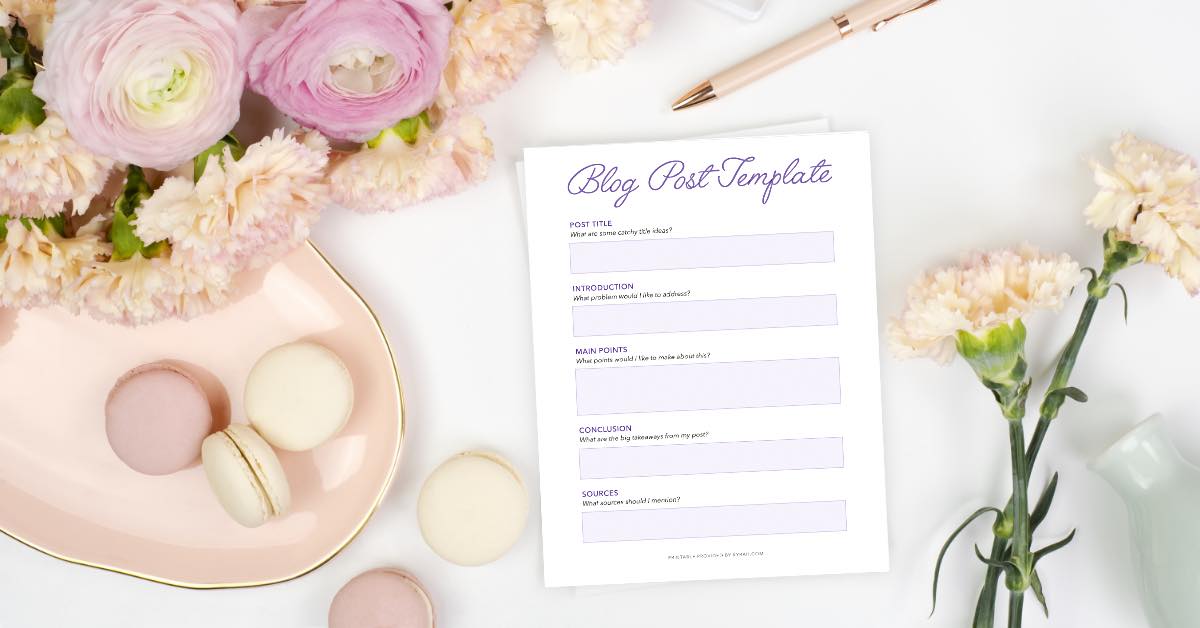When I started writing on the internet many eons ago, my process was free-form and rarely had any meaningful structure. It’s amazing that I found success at all because honestly, it wasn’t my best writing… and sometimes, embarrassing even. But I’ve discovered that it’s a heck of a lot easier and more effective to convey a message to others via blog posts when following a framework overly reminiscent of the last minute academic papers I wrote as an English major.
If you’re unfamiliar with this formula or need a refresher, read on to find out how to write a blog post and why this method works for nearly any topic. Plus, download a free printable template at the bottom of this post!
Start with a catchy and informative title
This one is probably obvious, but with so much content on the internet, you will have to find a way to stand out to get those clicks. Motivate your readers with a title that promises to solve a problem, educate, or entertain. Ask: Why should anyone care about this?
Appeal to emotions with enticing adjectives and follow through on what you promise to avoid clickbait stigma. Also, your title should include one keyword to guide readers toward your post while remaining under 55 words total to avoid getting cut off by the search results page.
More information can be found in my post about writing headlines.
Present a thesis statement in your introduction
Congratulations! You got that click. Now, how will you hook your readers? Your introduction should dig a little deeper into what you previewed in the title. What are you hoping to express to the reader throughout this post?
Seek relatable situations to connect with your audience and set forth expectations. A great way to do this is by telling a story in a casual, conversational tone. Would you be curious to hear more if someone started telling you this in person? Lay breadcrumbs of interest every step of the way.
Use the body to backup your thesis with evidence
Brainstorm at least 3 main points to reinforce your claim. In many cases, research is vital to proving these points effectively. Get the facts from reputable sources and interpret what you’ve learned in your own words, tying together personal experiences and observations whenever possible. Don’t plagiarize and cite sources when appropriate (see further below for more on this).
- What problems do I want to solve?
- How can those problems be addressed?
- Do others agree with my stance?
Suppose my thesis aims to solve the problem of effectively marketing a blog using social media. One of my main points might discuss how to use Pinterest to advertise posts. I could explain why this platform is optimal for doing so and include examples or statistics as proof.
Since this section is the meat of your post, be sure to avoid dreaded walls of text by breaking each point into a paragraph or more. Use bullet points and formatting such as bold and italic text to draw the eye toward anything you’d like to highlight. Add headings to make your post skimmable and provide whitespace. Create visual interest by adding images that illustrate your message.
Tie everything together in your conclusion
The final paragraph(s) should simply reiterate the key takeaways from everything you’ve presented. Why should all this matter to your audience? What value have you provided them? Is there something they should do next?
If desired, your CTA (Call to Action) will probably be found toward the end of your post, asking your readers to do something. This might be a comment request, newsletter suggestion, or product recommendation. Either way, the end goal is that your readers have no regrets after investing their time here.
Don’t forget to give credit where it’s due
For blog posts, the citation is often placed within the text when quoting someone else, linking to a study, providing statistics, or including something that isn’t generally known. It’s usually worth including an inline link to that source. This shows where the information came from, provides contextual information, and creates valuable link building opportunities.
If you are writing something more academic or with heavy research, it may be more appropriate to list your sources as footnotes at the end of the article. Most journalism uses APA format for reference lists.
If any images or other media within your post require attribution, be sure to do so in the format and location requested by the owner.
Now that you have some basic guidelines, you’re nearly ready to dive in! But before writing your first draft, visit some of your favorite blogs and note how they format their best posts. What encourages you to keep reading and come back to these sites?
Keep in mind that the steps presented here are not the only way to write a winning blog post. Online expression can venture down many paths. However, following this outline can provide some direction and encourage readers to stick around for the journey.

